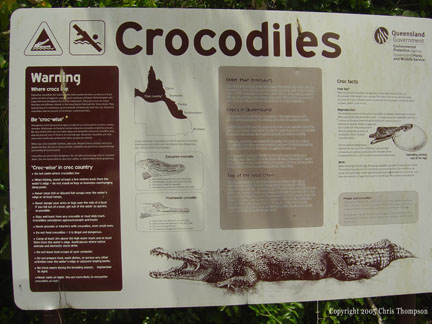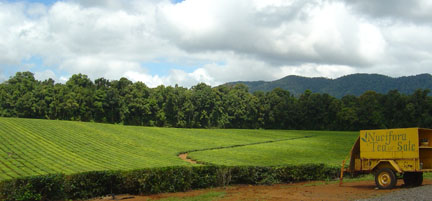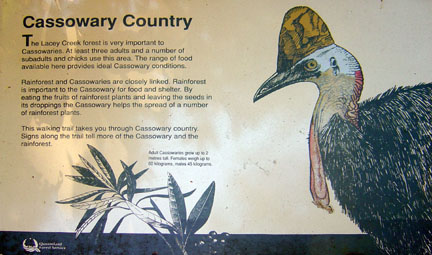Category Archives: Hip Guide to Australia
Daintree River Ferry Crossing
When traveling north on the Captain Cook Highway you will cross the Daintree River on the way to Cape Tribulation. Here you must use the ferry to cross the rapidly flowing croc infested Daintree River.

Charging 16 Australian Dollars (return) for the ride, this ferry operates on cables that cross the river.
The 21-car ferry runs from 6 AM thru Midnight 7 days a week.
Ten kilometers upriver from here is the village of Daintree, where you can hire a boat to explore the mangrove lagoons and see crocs up close.
Sugarcane in Australia

Cane Trains on the Coast of Queensland
Sugarcane has been cultivated for more than 2000 years by mankind. Botanically, Sugarcane is known as Saccharum officinarum, and it belongs to the family Gramineae. The grass’s two-inch thick stalk can grow as tall as 20 feet in densely packed rows.
Emergency Telephone Numbers Australia
Emergency Telephone Numbers in Australia:
Dial 000 for Police, Fire or Ambulance from anywhere in Australia.
Emergency Number from everywhere in Australia (from a mobile telephone, you must tell the operator from which state you are calling).
Embassy of the United States of America Chancery: Moonah Place, Yarralumla ACT 2600 Tel: (02) 6214 5600, Fax: (02) 6214 5970
British High Commission Chancery: Commonwealth Avenue, Yarralumla, ACT 2600 Tel: (02)6270 6666, Fax (02)6273 3236
Here is a link to a list of International Embassies in the nation’s capital, Canberra.
Crocodiles in Australia
and that is why you see warning signs such as these
when traveling thru the Wet Tropics of Far North Queensland in Australia.
Crocs rule here.

There are 23 species of crocodiles worldwide, but only two live in Australia, the estuarine (Crocodylus johnstoni) and the Freshwater (Crocodylus porosus).Freshwater crocs can only be found in Australia, and are seen in freshwater rivers, billabongs and swamps. You can track them down in Northern Queensland, the Cape York Peninsula and in the Gulf of Carpinteria regions.
Public Holidays in Australia 2006
Here is a list of Annual Holidays in Australia for the year 2006, with major events of note.
Nucifora Tea
Nucifora Tea is a delightful full-bodied smooth black tea grown outside Innisfail in the Wet Tropics of Far North Queensland in Australia. It is without a doubt one of the finest black teas I’ve consumed – ever

You can buy Nucifora Tea on the roadside or in shops.
Grown in the rich agriculture district of Palmerston, the Nuciforas have been growing tea here for more than 15 years. They only harvest the tender young tips of the plants, which produces top quality tea.
Nucifora Tea is grown without pesticides or herbicides in a tropical paradise. The weather in the area near Innisfail is surrounded by vast banana plantations, miles of paw paws, millions of acres of sugar cane, and pasture land stretching from the eastern fringe of coastal forests on the Coral Sea to the Atherton Tablelands to the west. This is a very special place.
Stop by any time, day or night, and get some tea from their roadside stand, just leave the few dollars they ask in the can and when you get home brew a pot of delicious tea from Queensland. Continue reading
Tree Kangaroos
The elusive Tree Kangaroo is found in Australia’s Queensland, where they flourish in the lush tropical forests. There are two species, the Lumholz and Bennett’s Tree Kangaroos. The Lumholz is named after the Norwegian naturalist C. Lumholtz, and are also known as “Boongary” with a scientific name of Dendrolagus lumholtzi. The Bennett variety is known as Dendrolagus bennettianus, and is larger than the Lumholz. Eight other species of Tree Kangaroos are to be found in New Guinea.
Both varieties are about two feet tall, but their tails are often three feet long! The female bears one young kangaroo at a time, and carries it in her pouch like all marsupials. They are found sleeping in the branches of trees during the day, and become active at night, being nocturnal. Tree Kangaroos can leap as far as 15 meters (45 feet) from tree to tree. They do not hop about on the ground like regular Kangaroos – they walk.
Australia’s Tree Kangaroos thrive on a diet of leaves and fruits gathered high in the forest canopy. Their large stomachs can handle the massive quantities of leaves they must consume to survive.
There are far more Lumholz Tree Kangaroos, spread over a large area of the Wet Tropics. The Bennett variety is only found in a small area around the Daintree River in Queensland.
The Cassowary Bird of Australia
According to the Wikipedia, the Southern Cassowary is the second-largest bird in Australia and the third-largest remaining bird in the world. Adult Southern Cassowaries are 1.5 to 1.8 m (5½ feet) tall and weigh about 60 kilograms (130 pounds). A reclusive forest dwelling flightless bird, they have a long sharp claw on each foot that can be used to rip out your guts if you get too close. There are historical references to Cassowaries killing humans, but they are shy creatures, and will seldom reveal themselves to the casual tourist.

Cassowaries are a protected species in Australia. Continue reading
Mobile Phone Access in Australia
Unlike Europe, the US & elsewhere, mobile phone use in Australia tends to be expensive. Telstra, Optus and Vodaphone are the big three operators for mobile telephony in Australia. Telstra, the once dominant monopoly in the country still offers uncompetitive rates and restrictions. Optus is little better, helping to keep high charges for everyone. Vodaphone is trying to lower the bar, offering better prices and more independence, but doesn’t have as wide a coverage as the other two. Virgin is another recent entry to the market in Australia.
When you buy a new phone and opt for any of the companies except Vodaphone, you’ll be committing yourself to using their service as they don’t let you switch sim cards without an extra fee (around A$80). If you already have a GSM phone, you can purchase a sim card from any of the companies for use in your phone. They usually come with $A25-$30 phone credit since they cost the same to buy.
In my experience mobile phone charges run about $1 per minute, and some even charge you extra for retrieving your voice messages. Text messages run around 25 cents unless you purchase a plan that gives you a better deal. So that $30 of credit can easily be used up with just a few calls.
If you’re going to be in Australia for awhile, it may be worth it to signup for a long-term contract, as the rates will be far cheaper than the prepaid plans. You can also get a better deal if you include your home phone and internet access on the same account.
Be aware that rural areas are not always covered by the major companies. Vodaphone in particular seems to concentrate on the major cities and towns, with poor service elsewhere. Hopefully this problem will be eliminated once the companies learn how to play together and share their lines without charging exorbitant rates.
Both GSM and CDMA mobile standards are in use in Australia. Supposedly the CDMA offers better rural coverage, but CDMA phones don’t use sim chips which means they won’t work in Europe and other areas.
We encourage you to not use Telstra as it costs the most, unless it is the only carrier available for your area.


 Hip Guide to Australia
Hip Guide to Australia